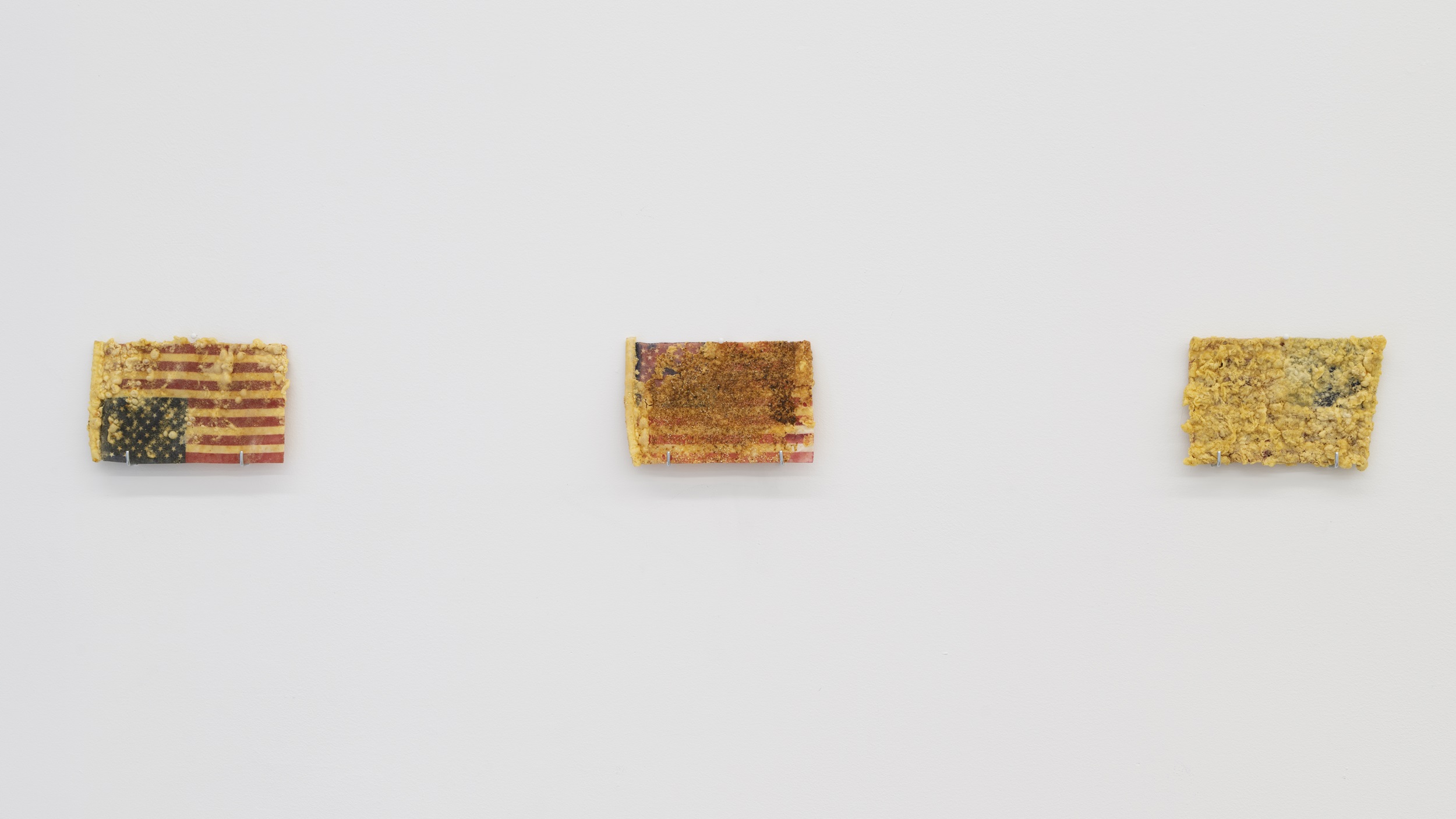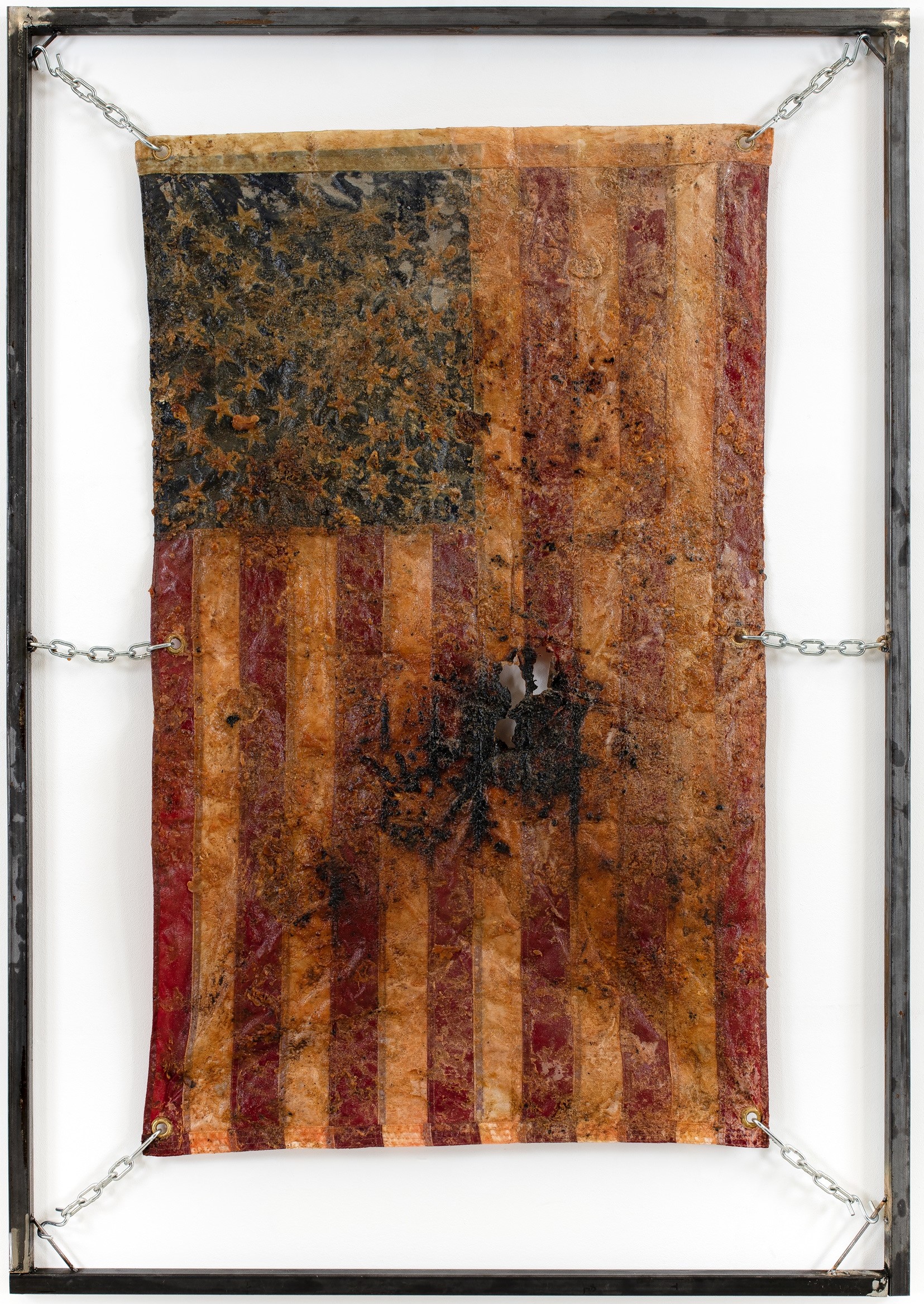Red, Fried, and Blue: Kiyan Williams Remakes the Flag
PDF: Gunter, Red, Fried, and Blue
Since 2020, multidisciplinary artist Kiyan Williams (b. 1991) has been amassing US flags ranging in scale (including flags they purchased that have flown atop the Capitol in Washington, DC), coating them in a batter made of eggs and seasoned flour, and submerging them in pots of boiling hot oil. These deep-fried flags emerge bubbled, charred, and encased in a thick browned or blackened crust, their stars and stripes at times barely discernible. Williams’s various concoctions of seasonings include those frequently used in Black American and Afro-Caribbean culinary traditions—they cite paprika as a personal favorite, as its red pigment adds a striking visual effect. At times, the artist will also fry the flags twice to further obscure their familiar stars and stripes. Once coated in a greasy exterior, they are transformed into static, seemingly edible objects that can no longer fly freely. Williams thus performs a material action that hastens the flags’ gradual and inevitable decay.

Williams became interested in frying flags after cooking and sharing recipes virtually with friends at the start of the COVID-19 pandemic. Describing cooking as a “sculptural process,”1 Williams realized its potential to manipulate and transform materials, ultimately turning to the US flag as a site for conceptual experimentation. In preliminary studies for this ongoing project, they mounted delicate four-by-six-inch fried flags in rows (fig. 1), while Williams’s 2023 series titled Fried and Suspended Flag displays larger flags suspended by chains within metal rectilinear armatures (fig. 2). A performance work in conjunction with the artist’s 2022 exhibition at Lyles & King Gallery in New York involved a communal frying of flags, for which Williams invited friends and neighbors to gather and contribute their own seasonings to the batter.

Through this project, Williams participates in a long-standing tradition of Black artists who critically engage with the US flag, including Faith Ringgold, David Hammons, Dread Scott, and Emma Amos. Williams similarly meditates on the star-spangled banner as a symbol not of patriotism but of hegemonic state power. Their particularly searing method of altering the flag also signals the violence on which the United States was founded and built, as well as how this violence has and continues to inform Black American histories and lived experiences. Through the textiles’ material transformation, Williams provides a critical lens—or an alternative meaning—to the flag and the messaging of liberty and justice it purports to communicate.
For the field of art history of the United States, Williams’s body of work offers yet another example of the fraught and complex position of the US flag in modern and contemporary art. The flag’s enduring presence in US-based art reveals the extent to which artists have sought to engage critically with this symbol’s individual and collective relationship to the nation: while some artists have featured the flag to express patriotic sentiments and national pride, others have used it to draw sharp criticism for centuries of state-sanctioned violence and marginalization. As scholars, curators, and researchers of “Americanist” art history continue to explore and establish the contours of this field, looking to this varied treatment of the flag can offer generative possibilities for areas of ongoing inquiry: What is the task of iconography in the making of national identity at large? What role do artists play in this creation? How and why are we expected to respond to certain icons, and what happens when those expectations are not met? How does the flag, in particular, assume different meanings across time, place, and circumstance? Finally, when artists like Williams materially alter objects and symbols that identify some kind of national belonging, how might their actions overlap with our own modes of undoing and remaking our understanding of nationhood? These questions, among others, can allow for deeper engagement with not only the US flag but also with other iconographic images and objects meant to represent so-called American values in the art of the United States.
By probing the very meaning of national identity and illuminating the often-contentious relationship between a nation and its people, Williams’s body of work allows for a robust and expansive understanding of the ways artists respond to the United States’ past and present. It is imperative that the field of US art history continue to embrace artists like Williams, who call into question a presumed allegiance to national imagery while asking us to unravel our own responses to it.
Cite this article: Adria Gunter, “Red, Fried, and Blue: Kiyan Williams Remakes the Flag,” in “American Artists x American Symbols,” ed. Katherine Jentleson, Panorama: Journal of the Association of Historians of American Art 10, no. 2 (Fall 2024), https://doi.org/10.24926/24716839.19340.
Notes
- Kiyan Williams, quoted in Taylor Dafoe, “Why This Artist Is Deep-Frying American Flags—and Inviting Guests to Bring Their Favorite Seasonings for the Batter,” artnet, June 3, 2022, https://news.artnet.com/art-world/kiyan-williams-deep-fry-american-flags-2125291. ↵
About the Author(s): Adria Gunter is a curatorial assistant at the Studio Museum in Harlem.

